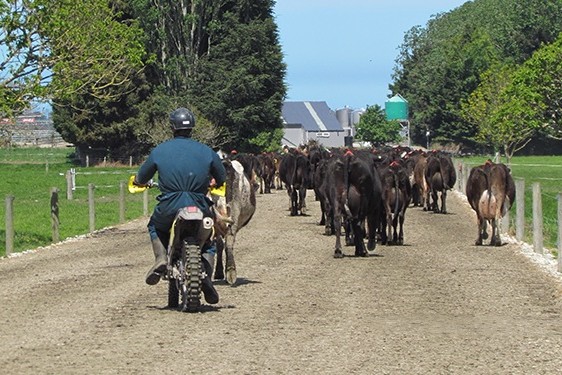Phil Edmonds
Two key pieces of strategic work commissioned by the Government released over the past couple of months show investing in technology is a critical enabler in making work more attractive, and in the case of the primary sectors, how it can better deliver workers the skills they need.
At the beginning of November Agriculture Minister Damien O’Connor unveiled the Food and Fibre Skills Action Plan for 2019-2022, designed to address labour shortages in the primary sectors. The plan is a response to the well-documented struggle to both attract new people and successfully train them and is a collaborative effort incorporating leaders from across the industry, government and education.
The importance in making this investment is obvious with access to workers, and especially workers with the right skills, now increasingly viewed as a roadblock to fulfilling the primary sector’s potential growth.
“It’s estimated the primary sector will need another 50,000 workers by 2025 and over 92,000 more workers with qualifications,” O’Connor said.
‘Fast-growing urban areas do not necessarily specialise in rapidly growing sectors or even offer particularly high wages. Some have expanded because they offer favourable amenities.’
While alarming, the scale of the challenge is not something that has crept up on the sector. O’Connor somewhat opportunistically noted the immediate action required is due to “nine years of neglect”. Irrespective of his point-scoring jibe, it is true that a co-ordinated response has taken its time to emerge. We’ve known for some time the primary sector has a distinctly ageing workforce, while attitudes to work have changed making it harder to attract young people to rurally based roles that involve manual labour.
Among the concrete actions to be undertaken in the coming three years are the development of a targeted marketing plan to attract more people into food and fibre education, support the development and delivery of micro-credentials specific to vocations and encourage the adoption of excellent workplace practices.
The two key advances in this new determined effort to address the problem is first, the buy in from those throughout the agriculture and horticulture sectors. The working group that put the plan together includes representatives from Beef + Lamb NZ, Meat Industry Association, DCANZ, NZ Apples and Pears, DairyNZ and Federated Farmers. Secondly, the group has set an ambitious timeframe to achieve some noteworthy wins. By 2022 it is hoping neutral minds would have become positive towards primary sector careers and the education system will be rightly purposed and delivering people into those careers.
There appears to be genuine optimism that this is practically doable. But there are of course influences on the appeal of the primary sector work that remain beyond the sway of this action plan.
A few weeks before its launch, the Productivity Commission delivered a report on the evolution of work in New Zealand’s cities and towns over the past 40 years, as part of its inquiry into technological change and the future of work. Based on census data, the report found that since 1976 people have (unsurprisingly) transitioned from smaller to larger urban areas, and away from manufacturing and primary industries into ‘information-intensive’ sectors.
Of most significance for those hoping to reboot interest in onfarm primary sector roles, and probably less widely appreciated, is that people transitioning to urban areas isn’t necessarily due to the prospect of better or higher paid work.
“Fast-growing urban areas do not necessarily specialise in rapidly growing sectors or even offer particularly high wages. Some have expanded because they offer favourable amenities, especially a favourable climate.”
Half of this particular finding could be interpreted positively; the level of wages offered for onfarm work are sometimes pointed to as an obstacle, but this suggests (as has other analysis of job attractiveness) that pay is certainly not the be all and end all. Indeed, somewhat remarkably, the word ‘wages’ is not mentioned once in the 36-page Food and Fibre Skills Action Plan. However, the second part (the lure of amenities) presents a challenge beyond the immediate scope of a recruitment drive.
Amenities is at the top of Beef + Lamb NZ chief insights officer Jeremy Baker’s mind. Also a member of the Primary Industries Skills Leaders Working Group which directed the Skills Action Plan, Baker says for his sector, getting people to take jobs in relatively remote locations is among its biggest tests.
In terms of job attractiveness, “the quality of rural services is critical across the board, in healthcare and education services and technology infrastructure including broadband. If those services are not up to scratch it can be a barrier for people taking those jobs, particularly if they are bringing families to the job.”
The investment needed to maintain those amenities required to attract workers to sheep and beef farms at least, is going to be a challenge beyond the action plan’s focus on education and training, particularly if Government funding of social services is based on population.
A further finding in the Productivity Commission’s 40-year analysis of work was that towns specialised in agricultural processing have found it more difficult primary sector work that remain beyond the sway of this action plan.
A few weeks before its launch, the Productivity Commission delivered a report on the evolution of work in New Zealand’s cities and towns over the past 40 years, as part of its inquiry into technological change and the future of work. Based on census data, the report found that since 1976 people have (unsurprisingly) transitioned from smaller to larger urban areas, and away from manufacturing and primary industries into ‘information-intensive’ sectors.
Of most significance for those hoping to reboot interest in onfarm primary sector roles, and probably less widely appreciated, is that people transitioning to urban areas isn’t necessarily due to the prospect of better or higher paid work.
“Fast-growing urban areas do not necessarily specialise in rapidly growing sectors or even offer particularly high wages. Some have expanded because they offer favourable amenities, especially a favourable climate.”
Half of this particular finding could be interpreted positively; the level of wages offered for onfarm work are sometimes pointed to as an obstacle, but this suggests (as has other analysis of job attractiveness) that pay is certainly not the be all and end all. Indeed, somewhat remarkably, the word ‘wages’ is not mentioned once in the 36-page Food and Fibre Skills Action Plan. However, the second part (the lure of amenities) presents a challenge beyond the immediate scope of a recruitment drive.
Amenities is at the top of Beef + Lamb NZ chief insights officer Jeremy Baker’s mind. Also a member of the Primary Industries Skills Leaders Working Group which directed the Skills Action Plan, Baker says for his sector, getting people to take jobs in relatively remote locations is among its biggest tests.
In terms of job attractiveness, “the quality of rural services is critical across the board, in healthcare and education services and technology infrastructure including broadband. If those services are not up to scratch it can be a barrier for people taking those jobs, particularly if they are bringing families to the job.”
The investment needed to maintain those amenities required to attract workers to sheep and beef farms at least, is going to be a challenge beyond the action plan’s focus on education and training, particularly if Government funding of social services is based on population.
A further finding in the Productivity Commission’s 40-year analysis of work was that towns specialised in agricultural processing have found it more difficult case of those for whom debt costs are one of their biggest expenses. The growth in the dairy industry has meant many newly converted farmers are carrying higher levels of debt. This may be an impediment to investment in expensive and new (to New Zealand) technology.”
In terms of concrete examples where technology could be made to change (and improve) the shape of on farm dairying jobs, automated milking was cited as an opportunity. However, both Federated Farmers and DairyNZ noted uptake in NZ so far is modest, with only about 25 farms in total using it. DairyNZ expects milking will be more automated in the future, but it may still take several decades to be commonplace given both the economic considerations (referred to above) and the technology being properly fit for NZ pastoral systems.
The benefits of adopting automated milking are well identified – which include freeing farm employees from early starts and longer days due to the milking routines. DairyNZ has identified that the work of farm teams will be spread to other areas and there may be some reduction in overall teams per farm.
The lack of ‘fit’ for NZ systems is not something unique to dairy. Much has been made of automated fruit picking, for example, and the impact that would have on the demand for jobs in the horticulture sector. But as Erin Simpson, Apples and Pears NZ capability development manager and member of the Primary Industries Skills Leaders Working Group says, “People tend to think the transition to automation and robotics is going to happen next year. The reality is that the structure and architecture of our trees needs to change considerably before we can start using machinery that has been developed. We don’t anticipate there will be a great deal of take up for at least 10 to 15 years.”
That said, Simpson believes the sector is moving in the right direction.
“Even through automation might be years off, transition towards robotics is moving in the use of platforms, which enables eight or nine people to stand on a platform to pick the fruit rather than climb up and down ladders all day.
“This means the work will be opened up to a different community of workers, who may not be able to carry a 30kg bag of apples around their neck but are quite capable of standing on a platform and picking individual fruit for six or seven hours.”
For sheep and beef though, Jeremy
Baker thinks the correlation between improved technology and job appeal is limited.
“In our sector, better technology will not necessarily improve the attractiveness of work. There are other things we need to be clearer about that’s unique and different in working in our sector. We can likely to be more successful in being clearer about offering other values – working outdoors, and connecting with nature for example, than the prospect of having your work enhanced by whizz bang technology.”
The Productivity Commission Inquiry has acknowledged the importance of investing in technology should be measured in the improvements it makes to the attractiveness (enjoyment) of work. If there are likely to be limits to this (as anticipated by Baker) then the value proposition should rightly be questioned.
The sheep and beef sector could well be following an alternatively advantageous path that focuses on addressing the factors that really matter to workers when making decisions about where to live and work (lifestyle and amenities).
DairyNZ is certainly ambitious in its desire to see technology adopted to make jobs easier and more enjoyable. And its voice is important, speaking for the greatest share of employees in the primary sectors.
In its submission to the Productivity Commission’s Inquiry, DairyNZ concluded it is committed to working with farmers to help inspire the creation of technologically advanced farms that make fundamental changes to the way people are utilised.
“Dairy farming is more than about improving productivity for economic gain, it is about owners and employees who enjoy their work and feel part of a community. Technology ultimately helps farmers utilise modern systems and tools which can represent a more attractive lifestyle change for workers, with a gradual shift away from more manual tasks to fewer hours worked.”
So back to the challenge of delivering on the Skills Action Plan promises and progressing the primary sector’s ‘attractiveness’. How can the marketing component, for example, effectively turn heads by talking up future-focused industries?
DairyNZ senior scientist Callum Eastwood said his organisation is working on a new workplace design project that suggests farms in 2030 will have technology that reduces the amount of physical work required, with more automated tasks making milking easier and shorter.
Training and upskilling will be enabled by the internet and there will be more learning from peers. Technology will make jobs and learning more enjoyable with the use of peer-learning through platforms like YouTube and smartphones to help new entrants get up to speed quickly.
The latter shift will no doubt help appeal to potential employees in the ‘lower-mid skill range’. DairyNZ people team leader Jane Muir says about 27% of all people on farm are ‘farm assistants’ and there is strong demand for these employees so thinking outside of the box is important to attract people.
Anything that will give them some ‘skin in the game’ (for example, the prospect of skill development through technology-enabled on-the-job learning) will hopefully reduce the high turnover in these roles and therefore the ongoing struggle to fill them.
All boiled down, the research and trends on workforce changes and worker preferences in NZ suggests technology deployment will be optimal if it makes work shorter, easier and more fun. And perhaps somehow, down the track, makes sure it comes with good weather and is close to the beach.





